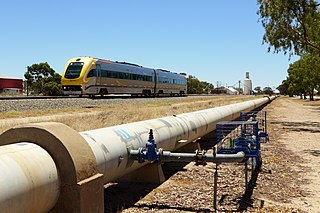
Coolgardie–Esperance Highway is a 370-kilometre (230 mi) Western Australian highway between Coolgardie and Esperance. It runs in a north–south direction linking the state's Eastern Goldfields to the coast.

Coolgardie is a small town in Western Australia, 558 kilometres (347 mi) east of the state capital, Perth. It has a population of approximately 850 people.

The Eastern Goldfields Railway was built in the 1890s by the Western Australian Government Railways to connect Perth with the Eastern Goldfields at Coolgardie and Kalgoorlie.

Civil disturbances in Western Australia include race riots, prison riots, and religious conflicts – often Protestant versus Catholic groups.

Frederick Charles Burleigh Vosper was an Australian newspaper journalist and proprietor, and politician. He was well known for his ardent views and support of Australian republicanism, federalism and trade unionism.

Secessionism has been a recurring feature of Western Australia's political landscape since shortly after Federation in 1901. The idea of self-governance or secession has often been discussed through local newspaper articles and editorials. On a number of occasions secession has been a serious political issue for the State, including in a successful but unimplemented 1933 state referendum.
The Kalgoorlie Miner is a daily newspaper circulating in the City of Kalgoorlie-Boulder and the Goldfields-Esperance region, in Western Australia.

The Goldfields Water Supply Scheme is a pipeline and dam project that delivers potable water from Mundaring Weir in Perth to communities in Western Australia's Eastern Goldfields, particularly Coolgardie and Kalgoorlie. The project was commissioned in 1896 and completed in 1903.

The City of Kalgoorlie–Boulder is a local government area in the Goldfields–Esperance region of Western Australia, about 550 kilometres (342 mi) east of the state capital, Perth. Covering an area of 95,575 square kilometres (36,902 sq mi), the city is larger than the country of Portugal with a land area of 92,212 square kilometres (35,603 sq mi). Its seat of government is the town of Kalgoorlie; all but 244 of the city's population live in either Kalgoorlie or Boulder.

Kalgoorlie railway station is the most eastern attended station in Western Australia, located at the eastern terminus of the Eastern Goldfields Railway. It serves the city of Kalgoorlie. Beyond Kalgoorlie, the line continues east as the Trans-Australian Railway.
The Western Argus was a newspaper published in Kalgoorlie, Western Australia, between 1894 and 1938.

A secession referendum was held on 8 April 1933 in the Australian state of Western Australia, on the proposal that the state withdraw from the Australian Federation. The proposal won a majority of the votes and a petition to give effect to the decision was subsequently sent to the British Parliament, where a parliamentary joint select committee ruled it invalid.

Gold mining in Western Australia is the third largest commodity sector in Western Australia, behind iron ore and petroleum, with a value of A$11.9 billion.
Mount Morgans, known as Mount Morgan until 1899, is an abandoned town in Western Australia 900 kilometres (559 mi) northeast of Perth and 40 kilometres (25 mi) southwest of Laverton on the original Malcolm-Laverton Road, in the Goldfields-Esperance region of Western Australia.
Niagara is an abandoned town located in the Goldfields-Esperance region in Western Australia, between Kalgoorlie and Leonora, 12 kilometres (7.5 mi) southwest of Kookynie.
State Batteries in Western Australia were government owned and run ore-crushing facilities for the gold mining industry. Western Australia was the only Australian state to provide batteries to assist gold prospectors and small mines. They existed in almost all of the mineral fields of Western Australia.
Alfred Thomas "Alf" Chandler was a journalist, editor and newspaper proprietor in Victoria, South Australia and Western Australia. He was prominent in the Western Australian secession movement.
The Coolgardie Miner was a weekly newspaper established in Coolgardie, Western Australia, at a time when Coolgardie was the prominent town in the goldfields region of Western Australia.

This is a list of newspapers published in, or for, the Goldfields-Esperance region of Western Australia.

The Chamber of Minerals and Energy of Western Australia (CME) is a peak business and employers' association in Western Australia (WA).













